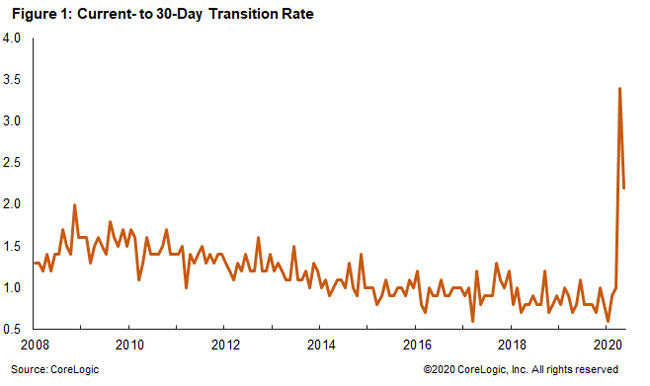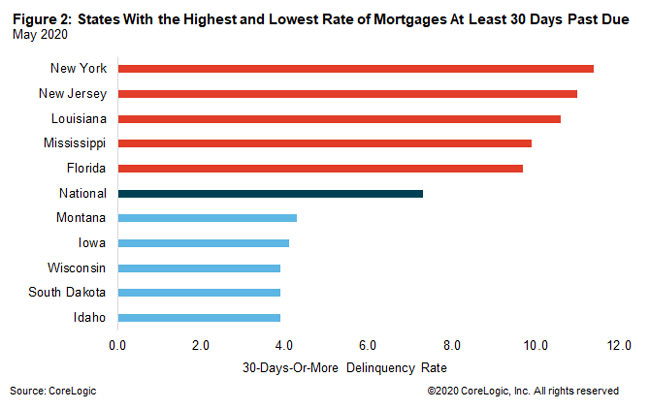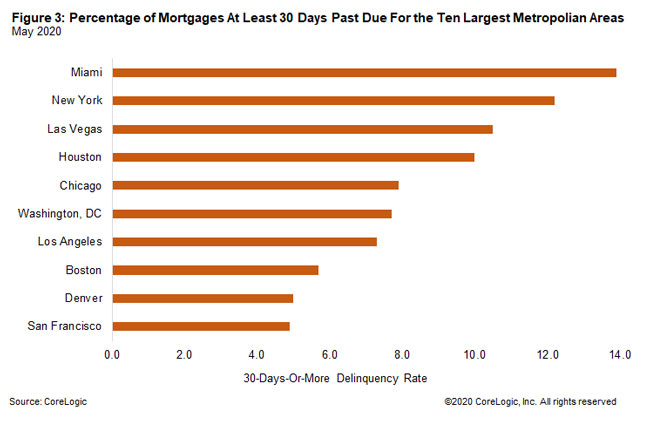
In May 2020, 7.3% of home mortgages were in some stage of delinquency (30 days or more past due, including those in foreclosure)[1], the highest overall delinquency rate since August 2014, according to the latest CoreLogic Loan Performance Insights Report. The May 2020 overall delinquency rate jumped 1.2 percentage points from the prior month as the impact of the coronavirus pandemic and resulting recession made it difficult for borrowers to make their monthly mortgage payments.
The share of mortgages that were 30 to 59 days past due – considered early-stage delinquencies – was 3% in May 2020, up from 1.7% in May 2019. Early-stage delinquencies progressed to the next stage in May with the share of mortgages 60 to 89 days past due increasing to 2.8% in May 2020, up from 0.6% in May 2019 and from 0.7% in April 2020.
The serious delinquency rate – defined as 90 days or more past due, including loans in foreclosure – was 1.5% in May 2020, up from 1.3% in May 2019. This was the first year-over-year increase in the serious delinquency rate since November 2010. The foreclosure inventory rate – the share of mortgages in some stage of the foreclosure process – was 0.3% in May 2020, down from 0.4% from May 2019 and matched April 2020 for the lowest foreclosure rate in at least 21 years[2].

In addition to delinquency rates, CoreLogic tracks the rate at which mortgages transition from one stage of delinquency to the next, such as going from current to 30 days past due (Figure 1). The share of mortgages that transitioned from current to 30 days past due increased to 2.2% in May 2020 from 0.8% in May 2019. While May 2020 the transition rate was lower than the April 2020 transition rate, it remained above the previous peak of 2% in November 2008.

Figure 2 shows the states with the highest and lowest share of mortgages 30 days or more delinquent. In May 2020, that rate was highest in New York at 11.4% and lowest in Idaho and South Dakota at 3.9%. All U.S. states posted annual gains in their overall delinquency rate in May 2020. The states that logged the largest annual increases were New Jersey (+6.4 percentage points), Nevada (+6.4 percentage points), New York (+6.1 percentage points) and Florida (+5.8 percentage points).

Figure 3 shows the 30-plus-day past-due rate for May 2020 for 10 large metropolitan areas.[3] Miami had the highest rate at 13.9% and San Francisco had the lowest rate at 4.9%. Miami had the largest increase in the overall delinquency rate of any metro, increasing 9.2 percentage points from a year earlier. Outside of the largest 10, all but two metros recorded an increase in the overall delinquency rate, with tourist destinations such as Kahului, Hawaii and Las Vegas, Nevada, as well as oil-dependent Odessa, Texas, showing the largest gains.
© 2020 CoreLogic, Inc. All rights reserved.
[1] Data in this report is provided by TrueStandings Servicing. https://www.corelogic.com/products/truestandings-servicing.aspx. The CARES Act provided forbearance for borrowers with federally backed mortgage loans who were economically impacted by the pandemic. Borrowers in a forbearance program who have missed a mortgage payment are included in the CoreLogic delinquency statistics, even if the loan servicer has not reported the loan as delinquent to credit repositories.
[2] The data in this report date back to January 1999.
[3] Metropolitan areas used in this report are the ten most populous Metropolitan Statistical Areas. The report uses Metropolitan Divisions where available.
To learn more about the data behind this article and what CoreLogic has to offer, visit https://www.corelogic.com/.







Sign up to receive our stories in your inbox.
Data is changing the speed of business. Investors, Corporations, and Governments are buying new, differentiated data to gain visibility make better decisions. Don't fall behind. Let us help.













Sign up to receive our stories in your inbox.
Data is changing the speed of business. Investors, Corporations, and Governments are buying new, differentiated data to gain visibility make better decisions. Don't fall behind. Let us help.





